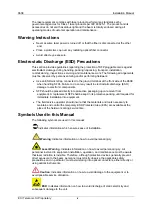
960E
Installation Manual
ECI Telecom Ltd. Proprietary
iii
Before You Start
Read This First
Important Safety Instructions
Safety Guidelines
This section contains information to help conduct a safe installation.
•
Installation of the equipment to be performed by qualified personnel only.
•
The equipment should be installed in a Restricted Access Area.
•
Ensure that the electrical grounding is connected as detailed in the document.
•
Grounding cables must be connected before connecting the power source.
•
Grounding cables should be marked minimum AWG 4 (21.2 mm
2
)
, rated at 300 V
with a 2.5m length maximum or perform a ground resistance test for 0.1
Ω
.
•
The DC power connection should be attached to the system first, and then attached to
the DC power source. The attachment to the power source terminals should be done
while the fuse or circuit breaker is in the “Off” position.
•
All equipment should be connected directly to the DC supply grounding electrode. All
equipment in the immediate vicinity shall be grounded in the same way, and shall not
be grounded elsewhere.
•
There should be no disconnecting device between the grounded circuit conductor of
the DC source (return line) and the point of connection of the grounding electrode.
•
Be sure to exercise proper Electrostatic Discharge (ESD) precautions when handling
the unit.
Electrical Safety Hazards
•
The DC power (-48/60 V
DC
) supplied to the unit from a local power source should have
a readily accessible listed branch circuit over-current protection two pole circuit
breaker of 70A maximum in the building installation or accessible to the service
person, servicing the unit. In case of less power consumption, use 125% of the
calculated shelf power consumption, see card power consumption table in Appendix
E.
•
Both power cords must be disconnected before servicing equipment.
•
The DC power supply should be local; that is, it should be on the same premises as
the equipment.
Laser Safety Hazards - Exposure and Compliance
Warning:
Because invisible radiation may be emitted from the aperture of the
port when no fiber optic cable is connected, avoid exposure to radiation and do not stare
into open apertures.
•
The fiber optics ports must never be exposed during operation.
•
Each of the ports must be connected to a fiber optic cable, terminated at the far end,
or covered with a proper protection cap supplied with the system.




































